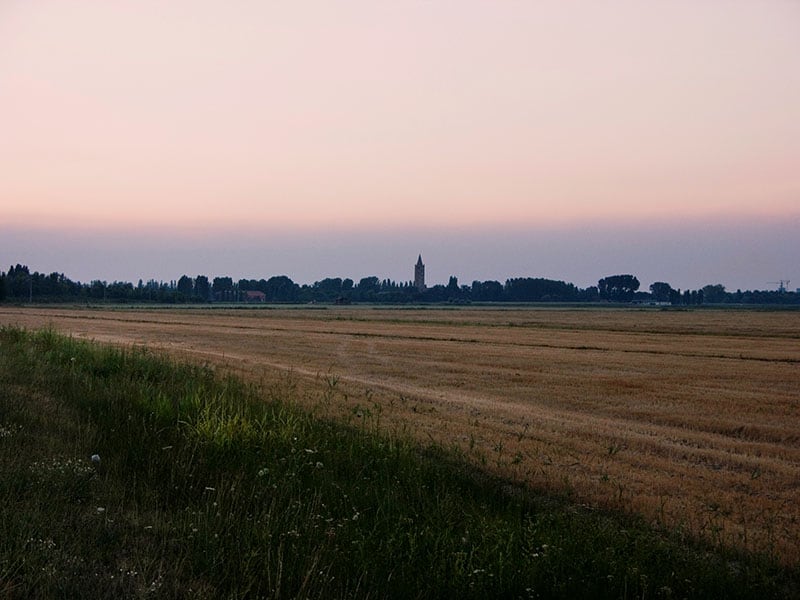The origins of the city

The origins of Ferrara are shrouded in mystery. Its name first appeared in a document from 753, issued by the Lombard king Desiderius, as part of the Exarchate of Ravenna. In 984, it became a fief of Tedaldo, Count of Modena and Canossa, nephew of Emperor Otto I, and was ruled by families such as the Adelardi; in 1101, it was besieged by Countess Matilda.
In 1146, with the death of the last of the Adelardi, Guglielmo, Ferrara passed as a dowry of his niece Marchesella to Azzolino d'Este. This was followed by years of internal strife between the Guelph party, led by the Adelardi family, and the Ghibellines, led by the Torelli-Salinguerra. After some hostilities with the Salinguerra family, Azzo Novello was appointed podestà for life in 1242, and in 1259 he captured Ezzelino of Verona in battle. He was succeeded by his nephew Obizzo II (1264–1293), who was appointed by the Pope as captain-general and defender of the Church State. The city, therefore, was a fief of the Canossa family and eventually achieved the status of a free commune. The Este family took advantage of the situation, securing lordship and absolute power over the city, overcoming many difficulties. The great cultural season of Ferrara began with the foundation of the University in 1391. Then there was a continuous crescendo of culture and splendor, bringing the Este Court to the highest European levels.
Humanists such as Guarino Veronese, artists of the caliber of Leon Battista Alberti, Pisanello, and Piero della Francesca, gathered in the city. The local school, called the "Officina Ferrarese," included names such as Cosmè Tura, Ercole de' Roberti, and Francesco del Cossa. All the greatest musicians of the time, including Josquin des Prez, worked at the court of the Dukes of Ferrara, making the Este Chapels the best in Europe.
Of great importance in the Ferrara of the Este family were the duchesses, who in many cases were no less important than their husbands. Eleonora, wife of Ercole I d'Este, was a tenacious and powerful woman; in the years of the war against Venice and her husband's subsequent depression it was she who governed the duchy with great skill, to Lucrezia, Alfonso I's wife and a lover of literature, Ludovico Ariosto dedicated many verses, the first on the evening of her entry into Ferrara for the wedding; Isabella, his daughter, became the beloved duchess of Mantua and Beatrice was married to Ludovico il Moro; Renata of France in an attempt to bring the transalpine lineage into the duchy was expelled as a heretic because she followed Calvinist ideologies.
Returning to the Este lineage, Nicholas III ( 1393 - 1441 ) hosted the council of Pope Eugene IV in 1438 and his son Borso received the fiefdoms of Modena and Reggio from Emperor Frederick III , becoming Duke in 1452 , and was later designated Duke of Ferrara in 1471 by Pope Paul II . His successor Ercole I ( 1471 - 1505 ) fought Venice, a war successfully continued by his son Alfonso I , who married Lucrezia Borgia (daughter of Pope Alexander VI and sister of Cesare Borgia ). In 1509 he was excommunicated by Pope Julius II and in 1512 he fought with the papal army, conquering Ravenna.
He managed to restore relations with the Papal States and was succeeded by his son Ercole II, married to Renata daughter of Louis XII of France, who reigned from 1534 - 1559 . His son Alfonso II, married to Barbara sister of Emperor Maximilian II, brought Ferrara to the highest point of its splendour. He had no male descendants and in 1597 Ferrara was declared a feud vacant by Pope Clement VIII.
The small state, always precariously balanced between its powerful neighbours, was incorporated into the Papal States in 1598. Centuries of decadence then began. After the Napoleonic interlude, Ferrara took an active part in the events of the Risorgimento and then in those of united Italy, until it became the modern city, but rich in memories of the past that we can still admire today.
With the Devolution of 1598, the city and the territory left by the Este family came under the direct political and administrative control of the Papal States, under whose rule they remained, with the exception of the Napoleonic interlude, until 1859, when Ferrara became part of the Kingdom of Sardinia. The transition marked an inevitable decline of the city. On the other hand, this allowed the preservation of the fabric of the mediaeval and Renaissance city, ‘saving’ it from the oversized and somewhat rhetorical intrusions of later centuries.
In the 18th century, the government of the city passed to the Cardinal Legates, who had great problems with a population exhausted by taxes.
In the 19th century, the city experienced an economic revival thanks to the discovery of its agricultural vocation. After the Napoleonic interlude, Ferrara took an active part in the events of the Risorgimento and then in those of united Italy, until it became the modern city, but rich in memories of the past that we can still admire today.
In the 20th century, the rediscovery and enhancement of the city's historical and artistic heritage gained importance, culminating in the city's inclusion on the UNESCO World Heritage List in 1995.

